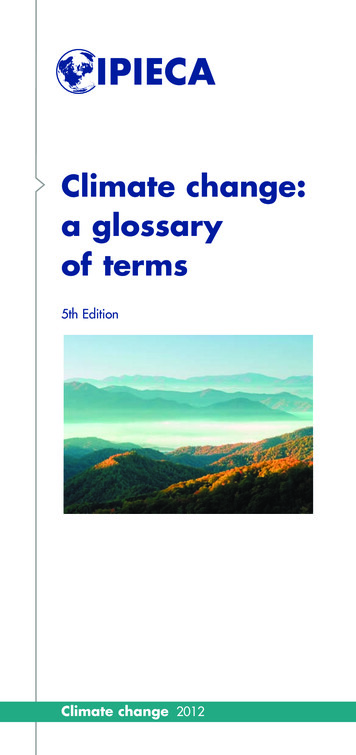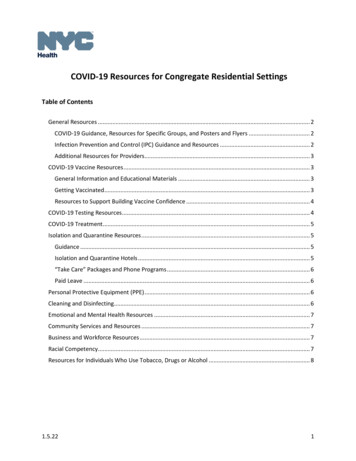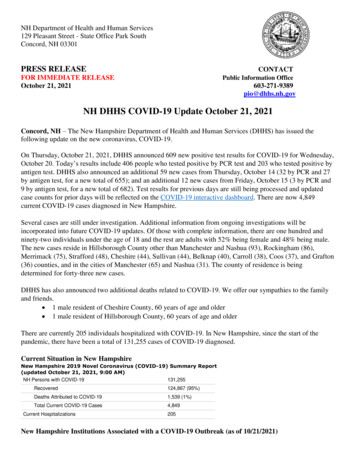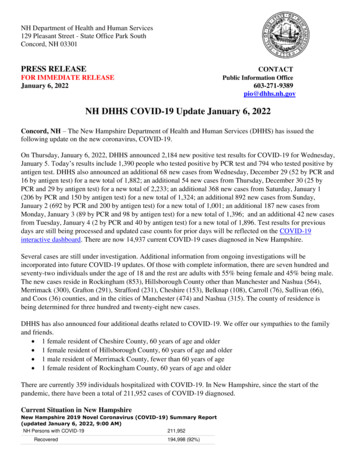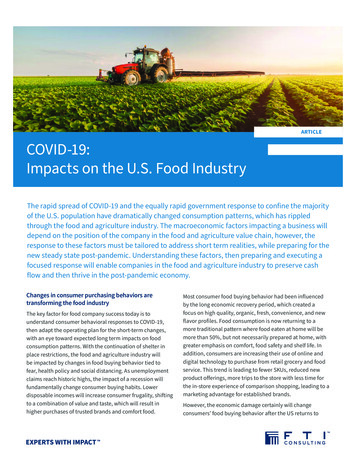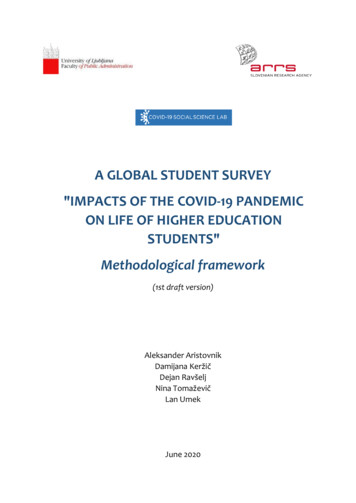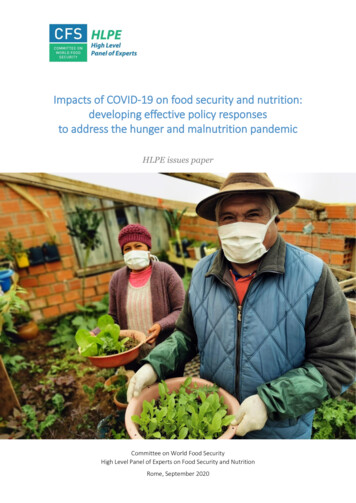
Transcription
Impacts of COVID-19 on food security and nutrition:developing effective policy responsesto address the hunger and malnutrition pandemicHLPE issues paperCommittee on World Food SecurityHigh Level Panel of Experts on Food Security and NutritionRome, September 2020
Cover photograph: FAO, 2020HLPE Steering CommitteeChairperson: Martin ColeVice-Chairperson: Bernard LehmannSteering Committee members:Barbara Burlingame, Jennifer Clapp, Mahmoud El Solh, Mária Kadlečíková, Li Xiande, Bancy MburaMati, William Moseley, Nitya Rao, Thomas Rosswall, Daniel Sarpong, Kamil Shideed, José MaríaSumpsi Viñas, Shakuntala ThilstedExperts participate in the work of the HLPE in their individual capacities, not as representatives oftheir respective governments, institutions or organizations.HLPE Joint Steering Committee / Secretariat drafting teamTeam Leader: Jennifer Clapp (Steering Committee)Team members: William Moseley (Steering Committee), Paola Termine (Secretariat)HLPE SecretariatCoordinator: Évariste NicolétisProgramme consultant: Paola TermineLoaned expert: Qin YongjunAdministrative support: Massimo GiorgiViale delle Terme di Caracalla00153 Rome, ItalyTel: 39 06 570 52762www.fao.org/cfs/cfs-hlpe/en : cfs-hlpe@fao.orgThis report by the High Level Panel of Experts on Food Security and Nutrition (HLPE) has been approved by the HLPESteering Committee.The views expressed do not necessarily reflect the official views of the Committee on World Food Security, of itsmembers, participants, or of the Secretariat. The mention of specific companies or products of manufacturers, whetheror not these have been patented, does not imply that these have been endorsed or recommended by the HLPE inpreference to others of a similar nature that are not mentioned.This report is made publicly available and its reproduction and dissemination is encouraged. Non-commercial uses willbe authorized free of charge, upon request. Reproduction for resale or other commercial purposes, including educationalpurposes, may incur fees. Applications for permission to reproduce or disseminate this report should be addressed by email to copyright@fao.org with copy to cfs-hlpe@fao.org.Recommended citation: HLPE. 2020. Impacts of COVID-19 on food security and nutrition: developing effective policyresponses to address the hunger and malnutrition pandemic. Rome. https://doi.org/10.4060/cb1000en
Impacts of COVID-19 on food security and nutrition:developing effective policy responses to address the hunger and malnutrition pandemicINTRODUCTIONThe COVID-19 pandemic that has spread rapidly and extensively around the world since late 2019has had profound implications for food security and nutrition. The unfolding crisis has affectedfood systems1 and threatened people’s access to food via multiple dynamics. We have witnessednot only a major disruption to food supply chains in the wake of lockdowns triggered by the globalhealth crisis, but also a major global economic slowdown. These crises have resulted in lowerincomes and higher prices of some foods, putting food out of reach for many, and underminingthe right to food and stalling efforts to meet Sustainable Development Goal (SDG) 2: “Zerohunger.” The situation is fluid and dynamic, characterized by a high degree of uncertainty.According to the World Health Organization, the worst effects are yet to come (Ghebreyesus,2020; Khorsandi, 2020). Most health analysts predict that this virus will continue to circulate fora least one or two more years (Scudellari, 2020).The food security and nutrition risks of these dynamics are serious. Already, before the outbreakof the pandemic, according to the latest State of Food Security and Nutrition report (FAO et al.,2020), some two billion people faced food insecurity at the moderate or severe level. Since 2014,these numbers have been climbing, rising by 60 million over five years. The COVID-19 pandemicis undermining efforts to achieve SDG 2. The complex dynamics triggered by the lockdownsintended to contain the disease are creating conditions for a major disruption to food systems,giving rise to a dramatic increase in hunger. The most recent estimates indicate that between 83and 132 million additional people (FAO et al., 2020)—including 38-80 million people in lowincome countries that rely on food imports (Torero, 2020)—will experience food insecurity as adirect result of the pandemic. At least 25 countries, including Lebanon, Yemen and South Sudan,are at risk of significant food security deterioration because of the secondary socio-economicimpacts of the pandemic (FAO and WFP, 2020). In Latin America, the number of people requiringfood assistance has almost tripled in 2020 (UN, 2020a). Food productivity could also be affectedin the future, especially if the virus is not contained and the lockdown measures continue.The purpose of this issues paper, requested by the Chairperson of the Committee on World FoodSecurity (CFS), is to provide insights in addressing the food and nutrition security implications ofthe COVID-19 pandemic and to inform the preparations for the 2021 UN Food Systems Summit.In March 2020, the High-Level Panel of Experts on Food Security and Nutrition (HLPE) publishedan issues paper on the impact of COVID-19 on food security and nutrition (HLPE, 2020a), and inJune 2020, its 15th report (HLPE 2020b) provided an update on the ways in which food securityand nutrition are affected by the pandemic. In the months following the publication of thesereports, we have seen many of the concerns outlined in these reports materialize and we havelearned more about the complex ways in which the pandemic has affected food security andnutrition.This issues paper updates and extends the HLPE’s earlier analysis by providing a morecomprehensive and in-depth review of the main trends affecting food systems that have resultedfrom COVID-19 and associated lockdown. It also expands the analysis of the pandemic’simplications for the various dimensions of food security (HLPE, 2020b).1Food systems include all the activities that relate to the production, processing, distribution, preparation andconsumption of food. The three constituent elements of food systems are: food supply chains, food environmentsand consumer behavior (HLPE 12, 2017). In this document, the term “agriculture” is used in its broad connotation,which includes farming, animal production, forestry, fisheries and aquaculture, and related activities.Page 1 of 22
Impacts of COVID-19 on food security and nutrition:developing effective policy responses to address the hunger and malnutrition pandemicIt is vital that the global community continue to monitor the situation closely, respond innecessary ways to avert the worst outcomes with respect to food security and nutrition, andcarefully consider how to build more resilient food systems and ensure the right to food, in orderto achieve SDG 2. The recommendations starting at page 10 of this document seek to provideguidance for how to proceed along these lines.1. HOW COVID-19 IS AFFECTING FOOD SECURITY AND NUTRITIONCOVID-19 is a respiratory illness and there is no evidence that food itself is a vector of itstransmission (ICMSF, 2020). However, the virus, and measures to contain its spread, have hadprofound implications for food security, nutrition and food systems. At the same time,malnutrition (including obesity) increases vulnerability to COVID-19. Initial and ongoinguncertainty surrounding the nature of the spread of COVID-19 led to the implementation of strictlockdown and physical distancing policies in a number of countries. These measures caused aserious slowdown in economic activity and disrupted supply chains, unleashing new dynamicswith cascading effects on food systems and people’s food security and nutrition. Below we outlinethese dynamics. We then highlight how these trends are affecting the six dimensions of foodsecurity proposed by the HLPE in its 15th report—availability, access, utilization, stability, agencyand sustainability—which are essential for ensuring the right to food (HLPE, 2020b).a. Dynamics unleashed by the pandemic are affecting food security and nutritionA number of overlapping and reinforcing dynamics have emerged that are affecting food systemsand food security and nutrition thus far, including: disruptions to food supply chains; loss ofincome and livelihoods; a widening of inequality; disruptions to social protection programmes;altered food environments; and uneven food prices in localized contexts (see, e.g. Klassen andMurphy, 2020; Clapp and Moseley, 2020; Laborde et al., 2020). Moreover, given the high degreeof uncertainty around the virus and its evolution, there may be future threats to food securityand nutrition, including the potential for lower food productivity and production, depending onthe severity and duration of the pandemic and measures to contain it. Below is a brief overviewof these dynamics, which are also depicted in Figure 1. These effects have unfolded in differentways as the pandemic has unfolded over its initial, medium, and potential longer-term impacts,as summarized in Figure 2.Page 2 of 22
Impacts of COVID-19 on food security and nutrition:developing effective policy responses to address the hunger and malnutrition pandemicFIGURE 1 The dynamics of COVID-19 that threaten food security and sruptedsocialprotectionUneven foodprice effectsChanges inproductionIncreasedpovertyandfood insecurityAltered foodenvironmentsSource: Authors.Supply chain disruptionsThere have been major disruptions to food supply chains in the wake of lockdown measures,which have affected the availability, pricing, and quality of food (Barrett, 2020). The closure ofrestaurants and other food service facilities led to a sharp decline in demand for certainperishable foods, including dairy products, potatoes and fresh fruits, as well as specialty goodssuch as chocolate and some high value cuts of meat (Lewis, 2020; Terazono and Munshi, 2020).As the pandemic-related lockdowns took hold in many countries in March-May of 2020, therewere widespread media reports of food items being dumped or ploughed back into the fieldsbecause of either collapsed demand or difficulties in getting these foods to markets (Yaffe-Bellanyand Corkery, 2020). Farmers without adequate storage facilities, including cold storage, foundthemselves with food that they could not sell.The movement of food through the channels of international trade was especially affected bylockdown measures. As borders closed and demand for certain food items dropped, foodproducers reliant on selling their crops via distant export markets were highly vulnerable,particularly those producers focused on perishable food and agricultural products, such as freshfruits and vegetables or specialty crops, such as cocoa (Clapp and Moseley, 2020). In the earlymonths of the outbreak of COVID-19, some food exporting countries also imposed exportrestrictions on key staple food items like rice and wheat, which led to some disruptions in theglobal movement of these staples as well as higher prices of these crops relative to others(Laborde et al., 2020). Certain countries, including those with high prevalence of food insecurity,are highly dependent on imported food and on commodity exports (FAO et al., 2019), which maymake them particularly vulnerable to these types of supply chain disruptions. Many of theseexport restrictions were lifted by August 2020, although the risk remains that such restrictionsmight be re-imposed, depending on the severity of any future spikes in the disease and the reimposition of lockdown measures.Page 3 of 22
Impacts of COVID-19 on food security and nutrition:developing effective policy responses to address the hunger and malnutrition pandemicDisruptions to food supply chains also resulted when food system workers experienced high ratesof illness, leading to shutdowns and some food processing facilities such as meat packing, forexample (CFS, 2020; Stewart et al., 2020). Labour-intensive food production has also beenespecially affected by COVID-19 among food system workers, including production systems thatrely on migrant farmworkers (discussed in more depth below), who face barriers to travel andwho often work in cramped conditions on farms and in food production facilities, some of whichhad to close temporarily to contain outbreaks (Haley et al., 2020).These disruptions to supply chains affected food availability in some cases, especially where foodswere not able to reach markets, which in turn put upward pressure on prices of some scarcegoods, as outlined below. The quality of food environments was also affected, leading to someshortages in fresh fruits and vegetables, also discussed below.Global economic recession and associated income lossesThe COVID-19 pandemic triggered a global economic recession which has resulted in a dramaticloss of livelihoods and income on a global scale (World Bank, 2020a). The resulting drop inpurchasing power among those who lost income has had a major impact on food security andnutrition, especially for those populations that were already vulnerable. Those in the informaleconomy are especially affected. In Latin America, for example, over 50 percent of employmentis in the informal sector (FAO and CELAC, 2020). According to the International LabourOrganization (ILO), more than the equivalent of 400 million full-time jobs have been lost in thesecond quarter of 2020 with a number of countries enforcing lockdown measures (ILO, 2020a).Developing countries in particular have been deeply affected, as they were already enteringrecession by late 2019 (UNCTAD, 2020a). Global growth is expected to fall dramatically in 2020,with various estimates showing a drop in the range of 5 to 8 percent for the year (IMF, 2020;OECD, 2020). Global remittances—a major source of finance in developing countries—areexpected to drop by around 20 percent (World Bank, 2020a).According to World Bank estimates, an additional 71 to 100 million people are likely to fall intoextreme poverty as a direct consequence of the pandemic by the end of 2020 (World Bank,2020a). The World Food Programme estimates that an additional 130 million people will faceacute hunger as a result of the crisis, nearly doubling the 135 million people already facing acutehunger (Khorsandi, 2020). Already, a number of severe hunger hotspots have emerged. As theUN reports, some 45 million people have become acutely food insecure between February andJune 2020, mainly located in Asia and Sub-Saharan Africa (UN, 2020b).As food demand has contracted due to declining incomes, food producers’ and food systemsworkers’ livelihoods are further affected: food systems are estimated to lose 451 million jobs, or35 percent of their formal employment (Torero, 2020). Similarly, the UN estimates that aroundone third of food system livelihoods are at risk due to the pandemic (UN, 2020b).Widening societal inequitiesThe global economic slowdown triggered by the pandemic, as well as the spread of the diseaseitself, has exacerbated existing societal inequities in most countries (Ashford et al., 2020). Theseinequities are affecting rights as well as access to basic needs such as food, water, and healthcare, and access to jobs and livelihoods, all of which have implications for food security andnutrition. Food insecurity already disproportionately affects those people experiencing povertyand who face societal discrimination, and it is these very people who are at higher risk ofcontracting COVID-19 and who have less access to health care services (Klassen and Murphy,2020). COVID-19 has also exacerbated inequities in access to safe sources of water and basicPage 4 of 22
Impacts of COVID-19 on food security and nutrition:developing effective policy responses to address the hunger and malnutrition pandemicsanitation. According to the WHO, one in three people lack access to safe drinking water andbasic handwashing facilities (WHO, 2020b). People without access to these services, which arevital for health and safe food preparation, are more likely to contract the disease, compoundingexisting inequities (Ekumah et al., 2020).Many food system workers face precarious and unsafe work conditions, which have beenexacerbated by the COVID-19 crisis. These workers are often paid low wages and lack protectiveequipment (Klassen and Murphy, 2020), and in some regions, such as in sub-Saharan Africa, Southand South-East Asia and some countries in Latin America, the majority work under informalarrangements (ILO, 2020b). Agriculture in many countries depends on migrant workers, many ofwhom work under casual employment arrangements where they have few rights and arevulnerable to exploitation (FAO, 2020a). As such, migrant labourers frequently face poverty andfood insecurity and have little access to healthcare and social protection measures. Migrant foodsystem workers have experienced higher incidences of COVID-19 infection as compared to otherpopulations (Klassen and Murphy, 2020), including because they are more exposed to the virusdue to cramped work, transport and living conditions (Guadagno, 2020). In some countries,lockdown measures have been coupled with temporary suspensions of workers’ rights (EuropeanParliament, 2020; IFES, 2020, online).Gender inequities have also been exacerbated by the crisis, as women face additional burdensduring COVID-19—as frontline health and food system workers, unpaid care work, communitywork, which has increased during lockdowns (McLaren et al., 2020; Power, 2020). Women arealso at risk of an increase in domestic violence due to the recession and confinement at homewhen lockdown measures are in place (FAO, 2020b; WHO, 2020a). These inequities affect womenand their prominent roles in food systems, including as primary actors ensuring household foodsecurity and nutrition, as well as being food producers, managers of farms, food traders, andwageworkers. According to FAO, the agricultural activities of rural women have been affectedmore than those of men (FAO, 2020b). This gender dimension is important because women, intheir caregiving roles for the sick, children, and the elderly, are likely at greater risk of exposureto COVID-19, with knock-on implications for food production, processing and trade (Moseley,2020).Disruptions to social protection programmesSocial protection programmes have been disrupted by the pandemic, which in turn are affectingfood security and nutrition. When the lockdowns began, most schools were closed, resulting inthe loss of school meal programmes in both high- and low-income countries. The WFP estimatesthat 370 million children have lost access to school meals due to school closures in the wake ofthe pandemic (WFP, 2020a). In some countries, governments and the WFP are developingalternative means by which to reach school-aged children with food assistance, including takehome rations, vouchers, and cash transfers (WFP, 2020b). While alternative school luncharrangements (such as in Cameroon (WFP, 2020c) may close the gap in some instances, in othercases such options are not in place, adding to the financial burden of poor households strugglingto feed their families (Moseley and Battersby, 2020).The global economic recession that resulted from the pandemic and measures to contain it havealso strained governments’ capacities to provide social protection for those most affected by thecrisis (FAO and WFP, 2020). In April, the G20 governments offered to freeze the debt servicepayments for 73 of the poorest countries, an initiative endorsed by the G7 governments, in orderto free up funds to address the fallout from the pandemic. Fully implementing this initiative hasbeen challenging, however, affecting the ability of the poorest countries to provide socialPage 5 of 22
Impacts of COVID-19 on food security and nutrition:developing effective policy responses to address the hunger and malnutrition pandemicprotection for their populations through this crisis. According to the UN Commission for Africa(ECA), Africa needs 100 billion to finance its health and safety net response (Sallent, 2020). Mostcountries may have or will need to borrow money to finance their response, but unfortunatelyseveral countries are constrained in how much they can borrow by already high debt to GDPratios (Sallent, 2020).Altered food environmentsFood environments have been deeply altered by the pandemic. Lockdown measures and supplychain disruptions outlined above have changed the context and thus the way people engage andinteract with the food system to acquire, prepare and consume food. The closure of restaurantsand food stalls meant people who relied on foods prepared outside the home for their mealssuddenly found themselves preparing food at home. But because of rigidities in supply chains,foods that previously were produced and packaged specifically for food service were not easilyrepackaged for retail sale and home use.As the COVID-19 pandemic unfolded, many countries moved to shut down informal food markets,which governments saw as spaces for potential disease transmission, reflecting a ‘formality’ biasin public health and food policy (Battersby, 2020). Informal markets are extremely important assources of food and livelihoods in developing countries (Young and Crush 2019). In South Africa,formal food retail outlets, which sell processed and packaged foods, were allowed to remain openwhile informal and open air food markets, which typically sell more fresh fruits and vegetables,were shut down (even though open air markets are actually safer in terms of person to persontransmission (Moseley and Battersby, 2020)). This move was especially detrimental to poorpeople who are more reliant on such markets for food because they can buy produce andfoodstuffs in smaller quantities. After lobbying from academics and civil society, these marketswere eventually allowed to reopen.Differentiated responses to these changes have emerged. A recent study suggests that poorhouseholds are likely to shift their spending away from fresh fruits and vegetables with highmicronutrient content to less nutrient-rich staple foods as a direct result of the pandemic(Laborde, Martin and Vos, 2020). Other studies also showed a shift towards consumption of moreprocessed foods (Bracale & Vaccaro, 2020). At the same time, in North America, there was aresurgence of interest in community supported agriculture (CSA) subscriptions, as peopleincreasingly grew concerned about the safety of shopping in supermarkets and desired moredirect access to fresh fruits and vegetables (Worstell, 2020), meat and fish products. CSA farms,however, were unable to meet all of this demand. There was also increased interest in home andcommunity gardening as people sought to grow their own food to ensure their food security andnutrition (Lal, 2020). These changes to food environments had variable impacts on food diversityand nutrition.Localized food price increasesGlobal cereal stocks are at near record levels and world food commodity prices overall fell in theinitial months of the pandemic. However, the overall food price index trends mask wide variabilityin food commodity prices in the wake of the lockdowns. Initially, prices for meat, dairy, sugar andvegetable oil fell sharply, while prices for cereal grains remained steady. As the pandemicdeepened, price trends have shifted, with meat prices rising, for example, as meatpackingworkers experienced high rates of illness in some countries and meat-processing plants closedtemporarily in order to halt transmission of the disease in worker communities (Waltenburg etal., 2020; EFFAT, 2020).Page 6 of 22
Impacts of COVID-19 on food security and nutrition:developing effective policy responses to address the hunger and malnutrition pandemicFurther, there have been localized price changes affected by the dynamics of the pandemic, withsome countries seeing localized food price increases, including countries that depend on foodimports (Espitia et al., 2020). For example, Venezuela and Guyana saw food price increases ofnearly 50 percent as of late July 2020, whereas Kenya saw food price rises of only 2.6 percent(FAO, 2020c). This uneven food price impact is the product of several complex factors, includingexport restrictions initially placed on some cereal crops such as rice and wheat by severalexporting countries, as noted above (Laborde et al., 2020). In the case of rice, for example, pricesincreased in Thailand, Vietnam and the US by 32, 25 and 10 percent respectively, betweenFebruary and mid-April 2020 (Katsoras, 2020). Currency depreciation in countries affected by theglobal recession also contributed to higher localized food prices for countries that rely onimported foods (UNCTAD, 2020a).Food price increases have also resulted from disrupted supply chains that have affected the costof shipping (FAO, 2020c). These localized price increases directly impact food security andnutrition by making food more expensive and thus more difficult to access, especially for peoplewith limited incomes.Potential for changes in productionAs noted above, global cereal stocks were at near record levels at the start of 2020, and foodsupplies generally were not in short supply. The dynamics outlined above, however, could changedue to the high degree of uncertainty surrounding the virus and its evolution and societal impact.It could potentially affect production levels going forward, depending on how long the pandemiclockdown measures last, whether they are repeated, and the uncertainty regarding the timingand extent of these measures.Labour-intensive crops, often cultivated with a migrant workforce in some countries, particularlyhorticultural products such as fresh fruits and vegetables, are likely to be more affected by thedisruptions noted above. Horticultural production, processing and export has expandeddramatically in many developing countries over the past several decades (Van den Broeck andMaertens, 2016), and these countries could experience production shocks due to labourshortages and transportation issues, which could affect incomes and thus food access. Cerealproduction, especially in industrialized countries where the use of highly capitalized equipmentis common, is less likely to be impacted (Schmidhuber and Qiao, 2020). Supply chains foragricultural inputs, such as seeds and fertilizer, has also been affected by lockdown measures,making them both scarce and more expensive, as has already been reported in both China andWest Africa (Arouna et al., 2020; Pu and Zhong, 2020).Page 7 of 22
Impacts of COVID-19 on food security and nutrition:developing effective policy responses to address the hunger and malnutrition pandemicFIGURE 2 COVID-19 impact on food systems over timeInitial effectsMedium termLonger term(first 1-2 months)(next 2-5 months)(next 6-24 months)Global and local disruptions to foodsupply chains due to lockdowns affectsperishable food items leading to foodwasteFarm labour and input constraints affectproduction and pricesLoss of livelihoods and people’s accessto food, resulting in a massive increasein hungerFood system worker illnesses contributeto continuation of supply chaindisruptionsLoss of food system livelihoodsthreatens food system stability andresilienceSchool closures mean loss of schoolmeals for millions of childrenGlobal recession sends millions intoextreme poverty, further diminishingtheir ability to access foodShift in diets to less nutritious foodsimpacts health and livelihood prospectsFewer fresh foods available in markets(fruits, vegetables, dairy, etc), leading topoor diet qualityUneven food price effects in localcontexts impact food import dependentcountriesOngoing uncertainty constrains longterm investment in the food andagriculture sectorEarly export restrictions by somecountries on some food products causessupply and price disruptionAltered food environments affectsaccess to healthy and nutritious foodsDiminished attention to climate andbiodiversity threatens food sustainabilityMassive job losses and incomeconstraints lower purchasing power,affecting food accessSource: Adapted from Clapp, 2020.b. Implications for the six dimensions of food securityThe dynamics outlined above affect food security and nutrition in complex ways. The HLPE GlobalNarrative report highlights six dimensions of food security, proposing to add agency andsustainability as key dimensions alongside the four traditional “pillars” of food availability, access,stability and utilization (HLPE, 2020b). The COVID-19 pandemic is affecting, or has been affectedby, each of these dimensions, illustrating the importance of each of these dimensions ininterpreting the food security and nutrition implications of the crisis, including the proposedaddition of agency and sustainability. These connections are discussed briefly below andillustrated in Figure 3.Availability: While world grain stocks were relatively high at the start of the pandemic and remainstrong, this global situation masks local variability and could shift over time. Grain production inhigh-income countries tends to be highly mechanized and requires little labour, making it lessvulnerable to disease outbreaks among farm workers. In contrast, cereals production on smallerfarms in lower income countries tends to be more labour intensive and female dominated. Incontrast to grains, supply chains for horticulture, dairy and meatpacking are more vulnerable tothe impacts of COVID-19 in higher income countries because of their more labour intensivenature, susceptibility to food worker illnesses, and corporate concentration leading to largerfarms and processing facilities where disease outbreaks may spread rapidly. Disruptions in supplychains for agricultural inputs could also affect food production
Committee on World Food Security High Level Panel of Experts on Food Security and Nutrition Rome, September 2020 Impacts of OVID-9 on food security and nutrition:


